No products in the cart.
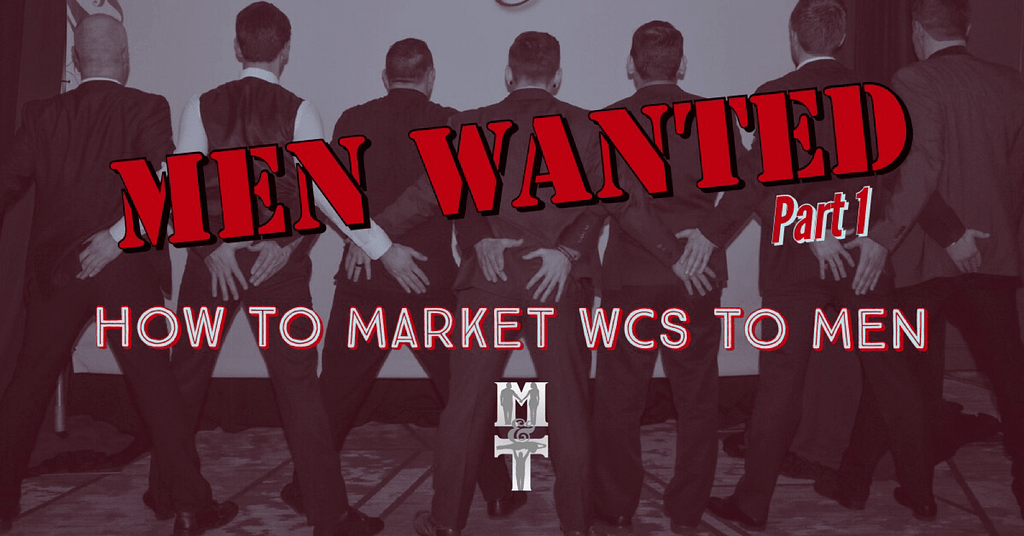
Men Wanted! How to Market WCS to Men (Part 1)
Reading Time: minutes remaining
We asked WCS MEN to tell us what would get them into class. You might be surprised what they had to say! Teachers and promoters: you’re going to love me – be sure to read to the end.
It’s a global phenomenon: most West Coast Swing scenes in the world struggle to attract men to try WCS in the first place, then struggle again to keep them training. How can we increase the involvement and engagement of men in WCS activities?
Let's be clear that in this article, we're talking about men in particular, not leaders. West Coast Swing has evolved where gender is irrelevant - any gender can dance either role. Therefore: if the struggle you're trying to overcome is role imbalance, there are many ways to support more people choosing to learn to lead. But that's for another article. This article is more about inclusion - trying to attract more males in particular to West Coast Swing, for a more balanced ecosystem.
To gather intel, I submitted a post on the Facebook group, Westie Discussion of Day, asking for MEN to answer only, about what initially motivated them to try WCS and what motivates them (or de-motivates them) to engage in classes/parties/privates/workshops.
The responses were honest, generous, and useful! In fact, this was SO useful, I decided to break it up in to two parts.
- Part 1 (this article): Attracting men to try WCS
- Part 2: Motivating men to increase engagement in WCS
Thank you to everyone who contributed. In fact, many men offered suggestions of their own accord, which I also included. I sorted through them all and noticed themes emerging. I could have paraphrased them, but I chose not to because I felt their direct quotes communicated their intention better, allowing readers to get a better understanding of how these men feel.
After each set below, I contribute my two cents, mixed in with some comments from my resident expert male, Myles, his retired dance teacher dad Ian Munroe, and our veteran Champion friend, Demetre Souliotes.
FYI, there’s a TON of suggestions in here that apply to any new dancer, not just the men.
Why am I “giving away all these secrets”?
- The teachers that we train are in the business of attracting new dancers, so we go above and beyond to support them both in how to do it effectively and efficiently, and in how to use Swing Literacy methods to guarantee they keep coming back and improving consistently.
- The whole dance world would benefit from attracting more dancers. More dancers = bigger community = more abundance for everyone involved!
Disclaimer:
The roles of leader or follower are irrelevant in this article, as is gender identity. I specifically was interested in men’s responses, but I did not preclude or filter out any responders. I did not specify roles, so responders were free to describe their experience from either role.
Swing Literacy does not endorse the comments made by the responders – they do not reflect the position of Swing Literacy.
This data is imperfect! Of course this is a small sample set of men, and all are English-speaking. My purpose was not to collect accurate data: my purpose was to get a basket-full of suggestions from men willing to contribute to solving this global dilemma. I encourage all dance teachers and event promoters to pay attention and analyze for themselves what these men had to say.
Here are the 5 questions I asked the men:
- What first attracted you to learn WCS? (answered here in Part 1, along with their offered advice)
- What inspired you to get more intentional in your learning? (Part 2)
- What is holding you back from taking more classes/workshops/privates? (Part 2)
- What marketing messages backfire on you/ offend you? (Part 2)
- What would make a difference for you now? What would inspire you now to study more? (Part 2)
Question #1 What first attracted you to start WCS?
“I was motivated by women"
- I started dancing for the social activity and because my wife dragged me.
- My girlfriend liked WCS.
- My best female friend told me how inclusive the scene was to LGBTQ individuals and that people would be willing to dance with me.
- I like how sexy it can be. Plus as a single, straight guy it’s a great way to meet women.
- Guys will be able to deduce that they will be able to “meet women” (or meet men), simply by observing the scene (especially when you say, “you don’t need a partner”). No need to shove it in their faces. (more on this in Part 2)
- Promote “meeting people” and “expanding social network” instead of specifically “meeting women”.
- Consider marketing to couples
- Consider displaying more diversity in your advertising
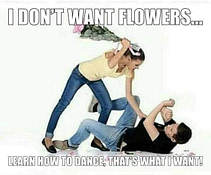
“I embraced overcoming a stereotype”
- I had the fortune of working with a professional male ballet dancer at my last job and he really changed my perspective on it, overcoming the common social stigma. He told me: “I chose to dance because I would rather work with beautiful women than wrestle around with a dude on the floor.”
- The opportunity to do something few men can actually do well.
- I couldn’t imagine dancing somewhere other than the bar scene I detested
- Promote taking pride in a skill everyone wishes they could do but not everyone has the guts to learn.
- Get them to visualize: Describe literally what you do at a dance party: arrive solo, change your shoes, go ask someone to dance (who will almost always say yes), say thank you after 3 minutes, then turn around and ask some one new to dance. No expectations, no strings attached.
- Contrast it to the social environment at a bar: most people are sober, everyone is there to dance, almost no rejection, dance with dozens of different people, single or not, music you can actually talk over, casual dance rules that are easy to learn and mistakes don’t matter.
- Reduce barriers to entry: Men are not as comfortable as women are pushing through the awkward learning phase. Tough love is not going to work at this stage.
- Provide lots of videos showcasing a variety of types, levels, and ages of men dancing WCS.
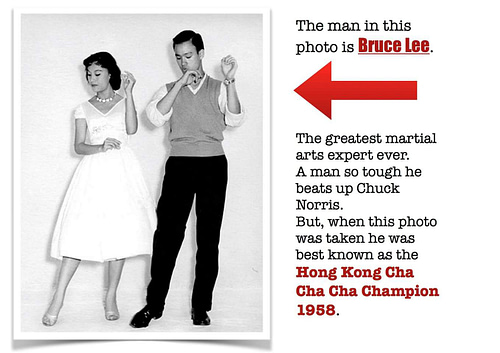
“I admired the men I saw”
- A friend of mine dragged me to a small social on campus, and watching other people dance WCS, just made me want to get good at the dance.
- I kept seeing WCS when I was already out dancing and thought it looked cool so I got myself to class.
- It was a random event at a bar, but one couple was dancing Westie and it looked like SO much fun that I went up to ask them about it.
- I was already learning Ceroc (Modern Jive) and saw a couple dancing WCS at my local venue, and was instantly fascinated by the quality of their timing and footwork.
- I wanted to improve (I’d just started dancing and I was dancing Modern Jive) and I really admired the dancing of a a friend of mine and he told me he also danced WCS.
- Stumbled upon a video from Kielbasa and Deluca and never looked back. ? From there the rest is history…
- I watched a couple at the ballroom studio dance WCS. It was definitely different then the ballroom version and wanted to know more.
- I started by learning from my girlfriend’s backleading. I don’t recommend this; developed terrible habits that I later had to unlearn. One day I saw a demo and realized that’s what it’s supposed to look like; fell in love – and immediate began group and private lessons.
- Men need visual examples they can relate to. Show young men examples of relatable people their age dancing well, but not competitors in costumes. Avoid images of men that the newbie can’t relate to. Avoid videos that look way beyond accessibility. Do the same for older men. Do the same for LGBTQ people.
- We intentionally chose this photo as our cover art for Myles’ men’s styling instructional video, Dance Like a Dude, because it features him more than me, he’s in a pose that exudes desirable qualities: strength, dominance, confidence, charisma, which are also taught in the video. Note: this video can be hugely beneficial for any gender. In the Swing Literacy programs, we support you developing your skills to express your styling anywhere on the spectrum you choose.
“I needed physical activity”
- What attracted me to dancing in general was the idea of doing something physical, social and creative on a regular basis.
- The health benefits specifically mentally of dancing.
- I was a competitive athlete, that had some major surgeries. While going through physical therapy & learning how to walk again, dancing was suggested as a way to improve my balance and weight transfer. I signed up at a dance studio for all the classes including WCS while still on crutches.
- To meet people who are active like myself and don’t just sit in a bar for hours in the same spot. If I stop dancing for 30 min, I leave.
- People are always on the look out for something fun to do that gets them out of the house. It has to be more rewarding than sitting at home alone playing video games.
- The words “physical” and “social” resonate with many men. Fewer connect with the word “creativity”, even though they learn to appreciate that aspect soon after starting.
Avoid words that the average person hasn’t learned to connect to yet: “connection”, “musicality”, “partnership”, “creativity”. - Consider marketing to men who were musicians, artists, or theatre geeks in high school but have now “aged up” and are looking for a new creative outlet to fill that void.
- A little tough love will work here: “Get off the couch and do something active and fun!”
- Compare learning the dance to learning to play a game or a sport
“I was seeking more out of dance”
- I finally made a serious attempt at WCS after over 20 years of Ceroc, and it took a while to unlearn a lot of habits. What I mostly needed during that time, apart from more classes, was more 2 or 3 room freestyles, where I could dip into WCS in a blues or chillout room, without having to commit an entire evening to it before I was ready to.
- I’ve been dancing Lindy Hop for 15 years and I’ve been learning other Swing dances in that time too. My girlfriend is a Westie and classes became available so I gave it a shot and love it.
- I remember being very quickly impressed and pleased at the diversity of music that WCS could be danced to. I enjoyed the level of connection and potential for experimentation and personalisation.
- Offer events with multiple rooms or a bar attached so people can wander in and try it out casually with the safety backup of being able to go back to their comfort zone at the bar or in the other dance room. (More on this later)
Men’s advice about how to market to non-dancer men
“Acknowledge their social motivations”
- Find college age single men, show them all the attractive women dancing. The smart ones keep coming back. From my experience, men tend to be motivated to start things because of pretty women. I can’t tell you how many things I’ve tried because of women.
- Realistically, it’s not the only motivation, but the most common motivation is “women”. But making that the theme of your marketing campaign is suicidal in our current dance culture.
For the record, (this topic will be expanded on in Part 2), while many men admit “meeting women” was a primary reason they sought out dance classes, specifically using women to market to men was strongly detested.
Many college-age single men are socially awkward and in need of some modelling, guidance, and facilitation in social skills. Dancing teaches them the social skills (such as communication, respect, and inclusive attitudes) they need to be more competent at meeting people in general, and the opportunities to practice. Promote that.
“Accommodate our egos”
- I suspect most men fear exposure: being bad at something in front of other people who aren’t bad at it. Many people hate the feeling that gives them – particularly adults and possibly adult men in particular. Women seem more likely to have learnt the basics of dance and rhythm when they are younger and less self-conscious. The pool of potential men willing to step up might be smaller in general.
- Stop telling them how difficult it is!
- Men are stubborn, arrogant, timid, insecure, etc. when men suck at something they will refrain from the embarrassment – most men want to learn how to dance, they crave it, but do not want to risk further embarrassment/rejection/or other insecure feelings they may have from times they experienced in the past.
- Show by an example, how the basics are really simple. Show a few videos where people dance well on a relaxed atmosphere.
- We are just trying to be accepted: There are a ton of hurdles to overcome, especially knowing that men can’t and/or are “not supposed” to be able dance.
- The most important part of it is: make us feel welcome! If we are accepted regardless of our skillset we most likely will stay much longer than we would personally expect.
Highlight the survival skill:
Never get stuck at a wedding again! Never again feel intimidated because you didn’t know how to dance.

Be transparent: tell it like it is:
Say “This dance is easy to learn. WCS is very forgiving. Everyone is super comfortable with not being perfect, with making mistakes.”
“Followers, have compassion for your partner – they are trying their best to juggle all these new skills.”
Reduce Barriers to Entry
Learning WCS does not have to be hard – when taught properly. We have taught teachers world wide how to get newbies dancing functional, connected, on-time basics in only 15 minutes that had them dancing all night and hooked enough to signup for real classes. See proof and find out how we do it
“Present the challenge”
- Make it technical enough to challenge us, so we will dive into it and from there will be able to develop a passion for it.
- Make it about US and how WE can be part of a bigger role called partner dancing.
Appeal to our competitive nature, the desire to be a better leader in life, conquering a new challenge that will impress our friends/family.
Feed the conquerer instinct:
Many men naturally gravitate to competing against each other, so play off that: they will be inclined to try to “achieve the thing” before their buddy does. Myles says when he goes rockclimbing with a buddy who is better than him, he will instinctively up his game to keep up with him. Men will try to one-up each other. So if two buddies attend a dance class, they might be more inclined to push each other to stick with it to see who can progress faster or last longer. Maybe offer a 2-for-1 deal.
To be competitive and avoid looking incompetent, men might be emboldened if they have a chance to learn more about it and prepare themselves before committing to trying it. This is a great time to introduce them to our Ultimate Rookie FAQ Bank article!
“Feature the music, but be prepared to back it up”
- I have always liked promoting a message that says: learn to partner dance to your favorite music including pop, hip hop, and more. I found that most people would love to learn how to partner dance, but are kind of turned off by the exotic or boring music.
- Might be good to target people who already do some dancing. The music genres and diversity are refreshing compared to other styles.
- I think West Coast Swing’s musical diversity is its strength and I think that talking about dancing to your favorite music has a mass appeal to it.
- If you are out there trying to attract new potential Westies, make sure you do you homework on your choice of music..:/
Music is an acquired taste
Your music tastes have changed since you started WCS. You started filtering through your preferred music to find the right rhythm and bpm you could use to dance WCS. Then you started listening to other people’s filtered collections, which again tuned your preferences. Now, you have included in your preferences (or built up a tolerance to) a wide range of music that you wouldn’t otherwise be attracted to before discovering WCS.
Now put yourself in the shoes of a non-dancer walking in to a dance party for the first time and seeing dancers thoroughly enjoying being “expressive” to somber, eclectic music that is under 70 bpm. To the non-dancer, this is not inspiring.
For the same reason that a social Tango milonga appears morose and boring to the outsider, the music required to attract a new WCS dancer is not the same music that inspires experienced dancers. They will develop an appreciation for other music tastes as they evolve as dancers, but the music needs to be uplifting, fun, and accessible in order to get the majority hooked in the first place.
“Remember what you’re selling”
- I believe that leaving the word “Swing” out of the initial approach keeps people from having the wrong idea or stereotyping it into what they believe Swing is (aka Big Band/Lindy Hop).
Depending on the person you’re talking to, you might need to avoid saying “Swing” unless you have their attention long enough to qualify it. Once they’ve seen it, you can label it freely, because they already are primed not to associate it incorrectly.
Avoid using graphics and stock images that don’t accurately depict WCS. If you still have a WCS logo or promo images with a man in a suit and a woman in a dress, it’s time for an update. Unless you also teach ballroom dancing, this image is misleading, which is likely to attract the wrong clientele and cause customers to mistrust you.
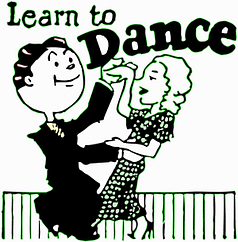
“Define your target customer and differentiate your marketing”
- You need to find the “why” with each individual or demographic. It’s difficult to market to men as a whole.
- If you want to attract more Westie guys you have to nail down how they think – what unites them as a group. You then have to find places outside West Coast Swing that have similar people. Then you have to market over there.
- The most success we had were gyms and country bars. Gyms because they would usually see us practice. Country bars because there is already encouragement for men to partner dance.
- Going to an engineering convention could work. Just make sure whatever you have planned for outreach won’t interfere with the convention proceedings. It can’t hurt to discuss what you have planned with the convention directors. (Like WCS EDs, they have to deal with a lot of issues.) Maybe promote an “engineers get in free” night at your local dance party.
- Just talk to the guys in your community. Figure out what else they do. Then advertise there to attract like minded people – birds of a feather flock together.
Good news, teachers & promoters: This is DONE for you!
Get a FREE SURVEY TEMPLATE
A free, editable template of a 20-question WCS Community Survey I made that you can send out to your dancers to get demographic data as well as intel about their needs and preferences!
I’m also including a second survey I created, made up of the 5 questions I asked on WDOD.
There’s so much more where this came from! To get access to these two surveys and get notified whenever we release teaching-related material, sign up for our Teacher Development Notifications:

Extra Wisdom
(Please add your own in the comments below!)
Creating the Environment
Let’s face it: dance studios are intimidating and sterile. They can’t help it! The vast open floor, “bright” lights, no corners to hide around, usually no inviting furniture to escape to, no alcohol… No matter how well-decorated it is, it’s still just a functional space that resembles a small school gymnasium, which can be a source of stress for many people of any gender.
I like to compare it to an indoor pool. Once you walk in the doors, you can either be on the deck or in the pool. Studios can be intimidating if there are only 2 choices: stand against the wall or dance. New dancers don’t have the vocabulary to describe the intimidation feelings, so they just say “I didn’t like it”, but they don’t really mean that they didn’t like the dancing: they might have liked the dancing part, but the environment wasn’t comfortable.
Every community needs one regular dance party to act as a “landing pad” or “initiation home base”. It needs to be cool and hip (Demetre’s word ? ); something that all dancers, regardless of age, will want to hang out in. The space needs to be as unintimidating as possible. A venue with a bar, dimmable lights, and lounge seating is ideal. In contrast to the indoor pool, this creates more of a “beach” setting: once you arrive, you can sit at a picnic table, spread out on the grass, sit on a log, layout on the sand, walk in the wet sand, wade in, or fully submerge for a swim. In a bar/lounge setting, you can engage in the scene at whatever level you are comfortable and still feel like you are participating.
Then after new dancers are “caught in the net”, they will gain the confidence to take lessons in an environment more dedicated to learning. It’s the responsibility of the promoters and DJ’s to consider and design whatever venue they have to be newbie-friendly.
Teacher’s responsibilities are:
- To teach WCS in a way that ensures success at every stage in the first few classes. Learn about the ideal method to introduce WCS to new dancers that gets them dancing, having fun, and hooked on the first night.
- To teach the culture of this social dance to all students, starting with your experienced students: explicity teach your dancers the intention of growing the community: “Do your part and reach out to new people. Do your part to be welcoming and encouraging. Remember what it was like for you when you started.”
It’s really hard to put yourself in the naive shoes you were in before you starting dancing. It’s hard not to use your now-wiser vocabulary and perspective when creating your marketing. But you must. People will not relate to you if you don’t use their language.
Remember what they’re buying
“In the beginning, you’re not selling West Coast Swing – you’re selling happiness.” ~Marc-Andre Forget, JiveStudio, Montreal, Canada
We are selling happiness through partner dancing. Even the first few classes are not really about WCS yet – they are about continuing to “sell” the student on this vehicle of happiness. Once they start to have some success and see how this activity can make them happy, only then will they be engaged enough to learn the specific aspects of WCS.

The mistakes many teachers make is trying to teach WCS details before the students are sold on this vehicle of happiness. Teachers who self-agrandize by over-complicating WCS in order to look smarter and gain respect just end up sabotaging the onboarding process. The #1 goal for day 1 is to come back to day 2: Keep it simple, make it easy to get; details will be lost on new dancers. Make it easy to love; pressure and intimidation won’t make them happy. When I’m shopping for a car, it doesn’t help me to open and read the car manual. What will convince me is getting a taste of the features that I think will make my life happier.
Happiness looks different for different people. Some people are lonely, so happiness looks like social opportunities. Some people have low-self esteem, so happiness looks like getting partner and teacher approval. Some people crave creativity, so happiness to them is finding a way to express that. Some people need structure, so happiness to them is learning the rules of the game and cracking the code.
Listing the outcomes and benefits, literally, without frills, gimmicks, or fluff, goes a long way to attracting men to trying partner dancing. Once they see proof of concept, they’re more likely to stick around and see how it turns out.
Bottom line:
Keep reading Part 2:
You must be logged in to post a comment.
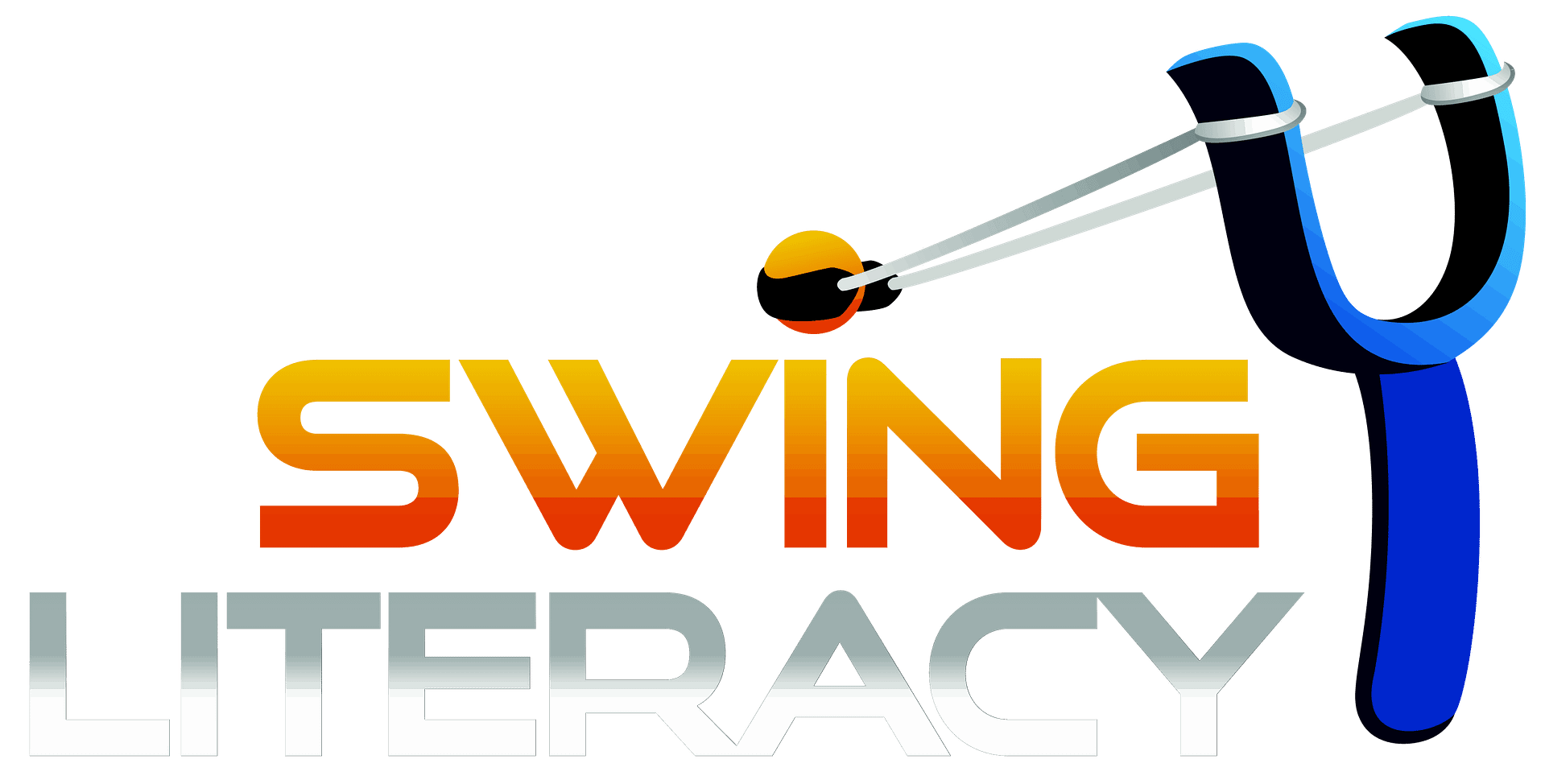
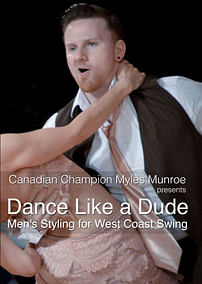

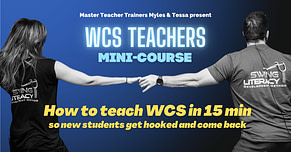

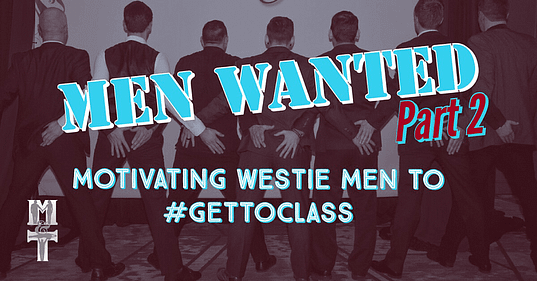










If WCS is wanting greater participation, I recommend being inclusive of people of any genders wanting to learn either role (lead/follow). The fact that major WCS competitions don’t allow women to lead or men to follow is truly regressive.
This was a really nice post. I have been teaching “West Coast Swing Online” and I would like to say that you are doing a great job. Although it takes some time to learn when you learn it gives a lot of satisfaction and happiness. Keep sharing your experience to motivate others.